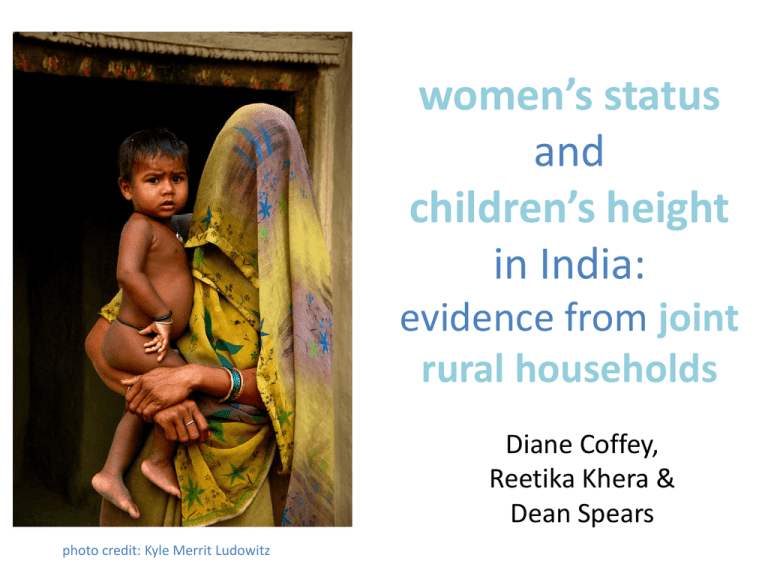
women’s status
and
children’s height
in India:
evidence from joint
rural households
Diane Coffey,
Reetika Khera &
Dean Spears
photo credit: Kyle Merrit Ludowitz
Indian children are short
• Indian children under 5 years old, are, on
average, 2 standard deviations below the
heights of children in the international
reference population (NFHS 2005)
• for a 5 year old girl, this is a deficit of about 10
centimeters, or 3.9 inches
introduction
height, health, and wealth
• height is a summary measure of early life
health
• height in childhood is correlated with height in
adulthood (Waterlow, 2011)
• height in adulthood is a marker of human
capital, economic productivity, and lifespan
(Case & Paxson, 2008; Vogl, 2011; Jousilahti et
al., 2000)
introduction
why are Indian children so short?
• energy going in: quality and quantity of food
– poor nutrition of pregnant and lactating women
– young children are fed little and late
• energy coming out: much early life disease
– intestinal disease: diarrhea and chronic enteropathy
– pneumonia and other infections
• could women’s status be something that
contributes to or aggravates these processes?
introduction
prior papers: children’s health reflects
women’s health
Ramalingaswami et al., 1996
• 36% of Indian women have BMIs below
18.5 (NFHS 2005)
• almost 60% of pregnant women are anemic
(NFHS 2005)
• weight gain in pregnancy is very low (WHO,
1995; Agarwal et al., 1998)
introduction
prior papers: women’s autonomy
Das Gupta, 1995
• in India, women have low status in their
child-bearing years, it grows as they age
• cultural norms around behavior in
women’s marital homes mean that they do
not seek resources for themselves or their
children
introduction
prior papers: it’s hard to identify an effect
of women’s status on kids’ health
several papers regress children’s anthropometric
indicators on an index of women’s status
variables
• omitted variables
• women’s status is hard to measure
– education?...seems to be different…
– some “empowerment” variables may suffer from
reporting problems
introduction
preview: our strategy
compare the children of higher and lower ranking
daughters-in-law in the same household
find that the children of lower ranking daughtersin-law are on average shorter than their cousins
born to higher ranking daughters-in-law
provide evidence for our interpretation of this
finding as an effect of women’s status on
children’s height
introduction
how could mother’s rank within
households affect children?
• in utero
– pre-natal nutrition and weight gain: a function of
consumption, work, and possibly stress
• during breastfeeding
– poor nutrition status may decrease quality of
breastfeeding
• ability to get resources for young children
– food: getting the right things to eat, and enough of
them
– disease: getting treatment
introduction
outline
o background—joint Indian households
o empirical strategy
o main results—the children of lower ranking
daughters-in-law are shorter than their
cousins
o interpretation—women’s status
o confirming lower status
o decision making, mobility & nutrition
o ruling out pre-marriage sorting
o ruling out differences in nuclear family resources
introduction
background
background
diagram of a joint household in our
sample
household heads
older brother
younger brother
children in our sample
background
fraction of rural households and
children under five in the NFHS living
in joint households
NFHS 1993
no daughters-in-law
one daughter-in-law
two daughters-in-law
more than two daughters-in-law
0.771
0.171
0.045
0.014
no daughters-in-law
one daughter-in-law
two daughters-in-law
more than two daughters-in-law
0.664
0.204
0.091
0.041
NFHS 1999 NFHS 2006
households
0.788
0.812
0.160
0.149
0.040
0.031
0.012
0.007
children under five
0.645
0.678
0.225
0.213
0.092
0.082
0.039
0.027
background
.25
where are the joint households?
.15
.2
UP
.1
BH
0
.05
RJ
MP
WB
MH
PJ KA
OR
HR
GJ
CHJH
KE
AP
AS
HP
JM
UC
TR TN
MN
GO
NA
DL
MZ
SK
AR
0
.05
.1
.15
.2
.25
percent of rural children under five in NFHS-3 data
background
Indian joint households
• are characterized by patriarchy and agehierarchy (Mandelbaum, 1948)
• older brothers are afforded higher social
status than younger brothers (Seymour,
1993)
• daughters-in-law defer to senior
members of their marital families
background
rank among daughters-in-law
• a wife inherits her husband’s status in the
household, which is determined by his birth
order (Singh, 2005)
• there are more people to whom a second
daughter-in-law must defer than a first
daughter-in-law (Mandelbaum, 2005)
• “senior wives tend to dominate young inmarrying wives” (Dyson & Moore, 1983)
background
empirical
strategy
empirical strategy
main regression
• low ranking motherih indicates that the child's
mother is the low ranking daughter-in-law
• h is a household fixed effect
• Aih is a vector of 120 age-in-months X sex
dummies
empirical strategy
• Dih is a vector of demographic controls about
the child
– dummy for first born to her mother, single birth,
mother’s age at birth, child’s birth order in joint
household
• Mih is a vector of controls about the mother
– height, years of education, age at marriage
• Fih is a vector of controls about the father
– education, age at survey
empirical strategy
main results
main results
in the same household, are
children of lower ranking
mothers shorter than children
of higher ranking mothers?
main results
nonparametric comparison of children
of lower and higher ranking DsIL
main results
children’s height & mother’s rank
main results
why control for child’s age?
main results
children’s height & mother’s rank
main results
demographic controls: are the
results driven by direct effects of
household size?
do grandmothers prefer their earlier
born grandchildren (or even the first
born), regardless of mothers’ status?
could having older cousins increase
babies’ exposure to disease?
main results
children’s height & mother’s rank
main results
height difference not due to comparing
children of different birth orders
main results
mother controls: do lower ranking
wives differ on pre-marriage
characteristics?
could women who are “less fit” to be
mothers become lower ranking
daughters-in-law?
main results
children’s height & mother’s rank
main results
height difference present for all
maternal heights
main results
father controls: could
resource differences
between “nuclear families”
(within joint families)
influence the results?
main results
children’s height & mother’s rank
main results
interpretations
1. confirming lower status:
decision making, mobility & nutrition
2. ruling out pre-marriage sorting
3. ruling out differences in nuclear
family resources
interpretations
interpretations: confirming lower status
decision making:
say in household decisions
in NFHS 3, does the woman have “final say” in
decisions related to:
• own health care?
• large household purchases?
• daily purchases?
• visits to her relatives and friends?
• what to do with the money her husband earns?
regress an indicator for “say” on intrahousehold
status using joint household fixed effects
interpretations: confirming lower status
decision making:
say in household decisions
lower ranking daughters-in-law similarly have
less “say” in the NFHS 2
interpretations: confirming lower status
mobility: time spent outside
women‘s mobility, particularly in the public
sphere, has been used by other researchers as a
measure of status (Rahman & Rao, 2004; Kabeer,
1999)
we analyze data from India Time Use Survey, 1999
– all adults in 12,750 rural households in six states
– 1.2% of rural households interviewed (n=312) had two
daughters-in-law
– data time use for the “typical” day before the survey
interpretations: confirming lower status
mobility: time spent outside
interpretations: confirming lower status
mobility: time spent outside
interpretations: confirming lower status
nutrition: body mass index
low body mass index scores of women in India
are an indicator of their malnourishment
low body mass index scores indicate poor prenatal nutrition, which has been shown to
influence children's height (Kusin et al., 1992;
Adair, 2007)
interpretations: confirming lower status
nutrition: body mass index
h
interpretations: confirming lower status
interpretations: ruling out pre-marriage sorting
no differences on pre-marriage
characteristics
interpretations: ruling out pre-marriage sorting
interpretations:
ruling out differences in nuclear family resources
no differences between brothers
can older brothers contribute more resources
to their children’s early life health than younger
brothers?
use NFHS 3 men’s survey to look at a
representative sample of brothers who live in
the same household
interpretations: ruling out differences in nuclear family resources
no differences between brothers
interpretations: ruling out differences in nuclear family resources
conclusion
conclusion
conclusion
• used a novel identification strategy to show the
children of lower ranking daughters-in-law are
shorter than the children of higher ranking
daughters-in-law
• interpreted this difference as evidence that
women’s status influences children’s health
• provided evidence that women’s status indeed
differs by daughter-in-law’s intrahousehold rank
• ruled out competing explanations for the result
conclusion
why it matters
• little prior well-identified evidence of an
effect of women’s status on children’s
health
• potentially broad implications for
human capital formulation
– other manifestations of low women’s
status may also hurt children
– other forms of hierarchy may also hurt
children
conclusion
comments? questions?
photo credit: Gates Foundation
conclusion
comparison of households in our
sample with other rural households
background
comparison of children in our sample
with other rural children under five
background
ways daughters-in-law defer
• veiling
• lowering her gaze
• sitting on the floor
• remaining quiet
in the presence of
senior men and
women
www.nationalgeographic.com
photo credit: dinodia.com
our
background
strategy
robustness check: larger sample
main results
no differences on pre-marriage
characteristics
are lower ranking daughter-in-laws inferior on
pre-marriage characteristics?
regress characteristics of mothers fixed before
marriage on intrahousehold rank and
household fixed effect
dependent variables: height, education, literacy, age
at marriage (from NFHS 3)
interpretations: ruling out pre-marriage sorting
nutrition: body mass index
"The person who cooked and the youngest
daughter in law, usually the same person, ate last.
This acted against her, even if there was no
conscious discrimination. Thus after feeding
unexpected guests, the person who ate last, the
cook, could prefer to do without rather than cook
again. In middle peasant households, often there
could be no vegetables or lentils left and she made
do with a pepper paste and/or raabri. In a situation
of deficit she went hungry when other household
members did not have to.” from: Palriwala, 1993 pg. 60
interpretations: confirming lower status
potential imitations
• identifying an effect within a select subgroup
of households
• the coefficient seems large, we hesitate to
interpret it quantitatively literally
• would like have more information on the
extent to which joint hh act as nuclear families
• no opportunities exist to replicate this in other
comparable Indian datasets as far as we know
conclusion
potential additions
• use NSS employment & unemployment survey
to look for differences between brothers’ work
• compare brothers’ time use using the ITUS
• your suggestions??
conclusion








